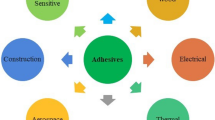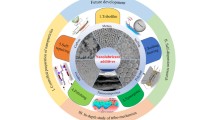Abstract
The effect of different transition metals (manganese, iron, and nickel) as alternative for cobalt additives toward the performance of rubber adhesion to brass has been investigated by employing modeling approach at density functional theory level. Out of the three different dopants, manganese shows positive results on both sulfide surfaces with notable improvement in adhesion on copper sulfide via carbon–carbon double bond. However, it exhibits lower promotional effect on zinc sulfide than cobalt dopant. Iron, on the other hand, only enhances the adhesion on copper sulfide, while inclusion of nickel displays the lowest promotional effect.




Similar content being viewed by others
References
Li XR, Wu HY, Cheng BC (2002) Trans Nonferrous Met Soc China 12:169–172
Fulton WS (2005) Rubber Chem Technol 78:426–457
van Ooij WJ, Biemond MEF (1984) Rubber Chem Technol 57:686–702
Chandra AK, Biswas A, Mukhopadhyay R, Bhowmick AK (1996) J Adhes Sci Technol 10:431–460
Hamed GR, Huang J (1991) Rubber Chem Technol 64:285–295
Fulton WS, Smith GC, Titchener KJ (2004) Appl Surf Sci 221:69–86
Mandal N, Sajith P, Agrawal SL, Bandyopadhyay S, Mukhopadhyay R, D’Cruz B, Deuri AS (2005) J Adhes 81:911–923
Sajith P, Ummer MT, Mandal N, Mandot SK, Agrawal SL, Bandyopadhyay S, Mukhopadhyay R, D’Cruz B, Deuri AS, Kuriakose AP (2005) J Adhes Sci Technol 19:1475–1491
Fulton WS, Sykes DE, Smith GC (2006) Appl Surf Sci 252:7074–7077
Jeon GS, Kim YM, Seo G (1998) Korean Chem Eng Res 36:179
Jeon GS, Seo G (2001) J Adhes Sci Technol 15:689–701
Ling CY, Hirvi JT, Suvanto M, Bazhenov AS, Markkula K, Hillman L, Pakkanen TA (2017) Theor Chem Acc 136:2–7
van Ooij WJ (1977) Surf Sci 68:1–9
Chandra AK, Mukhopadhyay R, Konar J, Ghosh TB, Bhowmick AK (1996) J Mater Sci 31:2667–2676
Buytaert G, Coornaert F, Dekeyser W (2009) Rubber Chem Technol 82:430–441
Persoone P, De Volder P, De Gryse R (1994) Solid State Commun 92:675–680
Hammer GE (2001) J Vac Sci Technol 19:2846–2850
van Ooij WJ (2003) in Crowther B (Ed.) Handbook of Rubber Bonding, Rapra Technology Ltd UK, pp 163–195
Fulton WS, Wilson JC (2003) in Crowther B (Ed.) Handbook of Rubber Bonding, Rapra Technology Ltd UK, pp 197–212
Ling CY, Hirvi JT, Suvanto M, Bazhenov AS, Ajoviita T, Markkula K, Pakkanen TA (2015) Chem Phys 453–454:7–12
Jaffe JE, Zunger A (2001) Phys Rev B 64:241304
Wright K, Watson GW, Parker SC, Vaughan DJ (1998) Am Mineral 83:141–146
Korzhavyi PA, Abrikosov IA, Johansson B (1999) In MRS proceedings 608:115 Cambridge University Press
Dubrovin IV, Budennay LD, Mizetskaya IB, Sharkina EV (1983) Izv Akad Nauk SSSR Neorg Mater 19:1816–1819
Oliveria M, McMullan RK, Wuensch BJ (1988) Solid State Ionics 28:1332–1337
Dovesi R, Saunders VR, Roetti C, Orlando R, Zicovich-Wilson CM, Pascale F, Civalleri B, Doll K, Harrison NM, Bush IJ, D’Arco P, Llunell M (2009) Crystal09 User’s Manual. University of Torino, Torino
Perdew JP, Ernzerhof M, Burke K (1996) J Chem Phys 105:9982–9985
Ernzerhof M, Scuseria GE (1999) J Chem Phys 110:5029–5036
Adamo C, Barone V (1999) J Chem Phys 110:6158–6170
Grimme S (2006) J Comput Chem 27:1787–1799
Schäfer A, Huber C, Ahlrichs R (1994) J Chem Phys 100:5829–5835
Boys SF, Bernardi F (1970) Mol Phys 19:553–566
Acknowledgements
Financial support provided by the Finnish Funding Agency for Technology and Innovation TEKES and the European Union/European Regional Development Fund (ERDF) for the “Smart Active Materials” project (70058/11) and “Vauhtia Renkaisiin” project (3246/31/2015) is gratefully acknowledged. We acknowledge grants of computer capacity from the Finnish Grid and Cloud Infrastructure (persistent identifier urn:nbn:fi:research-infras-2016072533).
Author information
Authors and Affiliations
Corresponding author
Rights and permissions
About this article
Cite this article
Ling, C., Hirvi, J.T., Markkula, K. et al. Computational approach to study the influence of Mn, Fe, and Ni as additives toward rubber–brass adhesion. Theor Chem Acc 137, 64 (2018). https://doi.org/10.1007/s00214-018-2240-1
Received:
Accepted:
Published:
DOI: https://doi.org/10.1007/s00214-018-2240-1




